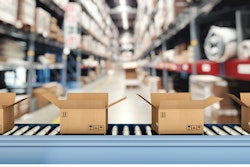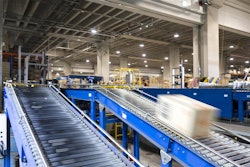Profiles in Supply Chain Enablement: Brewer outsources mobile asset management to reduce asset losses and production stoppage as it maximizes asset utilization
Company: Carlsberg UK (Northhampton, UK)
Company Size: Midsize
Company Sector: Manufacturing (Food)
Area(s) of Enablement: Order/Demand Capture, Procurement, Fulfillment/Logistics, Payment, Supply Chain Integration & Infrastructure, Decision Support
Enabler: TrenStar (Greenwood Village, CO)
 Case Study: U.K. brewer Carlsberg had invested tens of millions of dollars in a fleet of more than one million beer kegs that moved each day within the company's supply chain and that of its partners and their customers. But Carlsberg needed a better way to manage its mobile assets and control this keg fleet to maximize the return on assets. The company's goals included reducing losses of mobile assets (the beer kegs), improving visibility and asset utilization, eliminating new beer kegs purchases and improving customer service
Case Study: U.K. brewer Carlsberg had invested tens of millions of dollars in a fleet of more than one million beer kegs that moved each day within the company's supply chain and that of its partners and their customers. But Carlsberg needed a better way to manage its mobile assets and control this keg fleet to maximize the return on assets. The company's goals included reducing losses of mobile assets (the beer kegs), improving visibility and asset utilization, eliminating new beer kegs purchases and improving customer service
Carlsberg turned to TrenStar for its mobile asset management solution. The first challenge was to get visibility of these kegs as they move through this open supply chain: Where did they go? How long did they sit? When is this keg due for maintenance? Who was responsible for them? To answer those questions TrenStar deployed its radio frequency identification (RFID) solution for the brewing industry and TrenStarCM, its container management and tracking software.
Tagging the Kegs
TrenStar's brewing RFID solution combines tags, fixed readers and handheld terminals that have been specifically designed to work in harsh, high metal content environments. The solution provider tagged the keg fleet of more than one million kegs with passive RFID tags and installed readers in the brewery. They also reengineered handhelds to work in the brewing environment and to help capture data during delivery and pick-up.
Once the kegs were tagged, TrenStar implemented TrenStarCM (Container Management), which provides the visibility and reports to better track the assets and their contents, which helps with better asset management.
The system works as follows: as a keg moves through the supply chain, it is scanned. At each point in the supply chain, business rules are applied to make sure the right keg is in the right spot. TrenStarCM monitors the assets in the supply chain and provides reports to help make better decisions.
TrenStar monitors how many cycles a keg has and determines when maintenance is required. The solution provider also monitors when kegs have been sitting in a location for too long, as well as the contents of the keg, and they provide batch and lot tracking capability. The brewer uses this information to better control its supply chains, and Carlsberg also has the ability to monitor its partners, ensure content quality and lower supply chain costs.
ROI
Under TrenStar's operating model, its customers do not pay any upfront expenses for the solution. In fact, since they sell their assets to TrenStar, customers usually get large checks at the beginning of the deal and so do not have a large, upfront investments for technology and services.
The benefits Carlsberg received included reduced asset losses (50 percent reduction) and improved asset maintenance (10 percent reduction in costs, 15 percent reduction in in-trade failures), as well as reduced production stoppage due to keg starvation (reduced line stoppage inside the brewery by 50 percent in first year alone) and repatriated capital (cash for a keg fleet of over 1 million containers).
One of the significant benefits that TrenStar highlights as part of its model is the large amount of supply chain data generated by its systems. Through the Carlsberg implementation and those for TrenStar's other customers, the solution provider has been expanding the use of these data from the brewer's supply chain directly into the bar. The bar owners are interested in having these data because of the impact the information will have on better service and cost. Brewers and bars alike are set to benefit from better inventory management, order management, order to cash cycle times and transportation planning.
For more stories of successful supply chain implementations, read the "2005 Supply & Demand Chain Executive 100" article in the June/July 2005 issue of the magazine. Also watch the Today's Headlines section of SDCExec.com every Tuesday and Thursday for more in depth best practices drawn from this year's Supply & Demand Chain Executive 100.
Company: Carlsberg UK (Northhampton, UK)
Company Size: Midsize
Company Sector: Manufacturing (Food)
Area(s) of Enablement: Order/Demand Capture, Procurement, Fulfillment/Logistics, Payment, Supply Chain Integration & Infrastructure, Decision Support
Enabler: TrenStar (Greenwood Village, CO)
 Case Study: U.K. brewer Carlsberg had invested tens of millions of dollars in a fleet of more than one million beer kegs that moved each day within the company's supply chain and that of its partners and their customers. But Carlsberg needed a better way to manage its mobile assets and control this keg fleet to maximize the return on assets. The company's goals included reducing losses of mobile assets (the beer kegs), improving visibility and asset utilization, eliminating new beer kegs purchases and improving customer service
Case Study: U.K. brewer Carlsberg had invested tens of millions of dollars in a fleet of more than one million beer kegs that moved each day within the company's supply chain and that of its partners and their customers. But Carlsberg needed a better way to manage its mobile assets and control this keg fleet to maximize the return on assets. The company's goals included reducing losses of mobile assets (the beer kegs), improving visibility and asset utilization, eliminating new beer kegs purchases and improving customer serviceCarlsberg turned to TrenStar for its mobile asset management solution. The first challenge was to get visibility of these kegs as they move through this open supply chain: Where did they go? How long did they sit? When is this keg due for maintenance? Who was responsible for them? To answer those questions TrenStar deployed its radio frequency identification (RFID) solution for the brewing industry and TrenStarCM, its container management and tracking software.
Tagging the Kegs
TrenStar's brewing RFID solution combines tags, fixed readers and handheld terminals that have been specifically designed to work in harsh, high metal content environments. The solution provider tagged the keg fleet of more than one million kegs with passive RFID tags and installed readers in the brewery. They also reengineered handhelds to work in the brewing environment and to help capture data during delivery and pick-up.
Once the kegs were tagged, TrenStar implemented TrenStarCM (Container Management), which provides the visibility and reports to better track the assets and their contents, which helps with better asset management.
The system works as follows: as a keg moves through the supply chain, it is scanned. At each point in the supply chain, business rules are applied to make sure the right keg is in the right spot. TrenStarCM monitors the assets in the supply chain and provides reports to help make better decisions.
TrenStar monitors how many cycles a keg has and determines when maintenance is required. The solution provider also monitors when kegs have been sitting in a location for too long, as well as the contents of the keg, and they provide batch and lot tracking capability. The brewer uses this information to better control its supply chains, and Carlsberg also has the ability to monitor its partners, ensure content quality and lower supply chain costs.
ROI
Under TrenStar's operating model, its customers do not pay any upfront expenses for the solution. In fact, since they sell their assets to TrenStar, customers usually get large checks at the beginning of the deal and so do not have a large, upfront investments for technology and services.
The benefits Carlsberg received included reduced asset losses (50 percent reduction) and improved asset maintenance (10 percent reduction in costs, 15 percent reduction in in-trade failures), as well as reduced production stoppage due to keg starvation (reduced line stoppage inside the brewery by 50 percent in first year alone) and repatriated capital (cash for a keg fleet of over 1 million containers).
One of the significant benefits that TrenStar highlights as part of its model is the large amount of supply chain data generated by its systems. Through the Carlsberg implementation and those for TrenStar's other customers, the solution provider has been expanding the use of these data from the brewer's supply chain directly into the bar. The bar owners are interested in having these data because of the impact the information will have on better service and cost. Brewers and bars alike are set to benefit from better inventory management, order management, order to cash cycle times and transportation planning.
For more stories of successful supply chain implementations, read the "2005 Supply & Demand Chain Executive 100" article in the June/July 2005 issue of the magazine. Also watch the Today's Headlines section of SDCExec.com every Tuesday and Thursday for more in depth best practices drawn from this year's Supply & Demand Chain Executive 100.


















